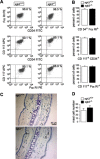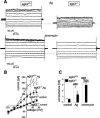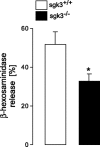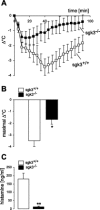Blunted IgE-mediated activation of mast cells in mice lacking the serum- and glucocorticoid-inducible kinase SGK3
- PMID: 20686074
- PMCID: PMC3774517
- DOI: 10.1152/ajpcell.00539.2009
Blunted IgE-mediated activation of mast cells in mice lacking the serum- and glucocorticoid-inducible kinase SGK3
Abstract
Previous studies have shown that pharmacological inhibition of the phosphoinositol-3 (PI3) kinase disrupts the activation of mast cells. Through phosphoinositide-dependent kinase PDK1, PI3 kinase activates the serum- and glucocorticoid-inducible kinase 3 (SGK3). The present study explored the role of SGK3 in mast cell function. Mast cells were isolated and cultured from bone marrow (BMMCs) of gene-targeted mice lacking SGK3 (sgk3(-/-)) and their wild-type littermates (sgk3(+/+)). BMMC numbers in the ear conch were similar in both genotypes. Stimulation with IgE and cognate antigen triggered the release of intracellular Ca(2+) and entry of extracellular Ca(2+). Influx of extracellular Ca(2+) but not Ca(2+) release from intracellular stores was significantly blunted in sgk3(-/-) BMMCs compared with sgk3(+/+) BMMCs. Antigen stimulation further led to a rapid increase of a K(+)-selective conductance in sgk3(+/+) BMMCs, an effect again blunted in sgk3(-/-) BMMCs. In contrast, the Ca(2+) ionophore ionomycin activated K(+) currents to a similar extent in sgk3(-/-) and in sgk3(+/+) BMMCs. β-Hexosaminidase release, triggered by antigen stimulation, was also significantly decreased in sgk3(-/-) BMMCs. IgE-dependent anaphylaxis measured as a sharp decrease in body temperature upon injection of DNP-HSA antigen was again significantly blunted in sgk3(-/-) compared with sgk3(+/+) mice. Serum histamine levels measured 30 min after induction of an anaphylactic reaction were significantly lower in sgk3(-/-) than in sgk3(+/+) mice. In conclusion, both in vitro and in vivo function of BMMCs are impaired in gene targeted mice lacking SGK3. Thus SGK3 is critical for proper mast cell function.
Figures





References
-
- Alessi DR, Deak M, Casamayor A, Caudwell FB, Morrice N, Norman DG, Gaffney P, Reese CB, MacDougall CN, Harbison D, Ashworth A, Bownes M. 3-Phosphoinositide-dependent protein kinase-1 (PDK1): structural and functional homology with the Drosophila DSTPK61 kinase. Curr Biol 7: 776–789, 1997 - PubMed
-
- Ali K, Bilancio A, Thomas M, Pearce W, Gilfillan AM, Tkaczyk C, Kuehn N, Gray A, Giddings J, Peskett E, Fox R, Bruce I, Walker C, Sawyer C, Okkenhaug K, Finan P, Vanhaesebroeck B. Essential role for the p110delta phosphoinositide 3-kinase in the allergic response. Nature 431: 1007–1011, 2004 - PubMed
-
- Andrade MV, Hiragun T, Beaven MA. Dexamethasone suppresses antigen-induced activation of phosphatidylinositol 3-kinase and downstream responses in mast cells. J Immunol 172: 7254–7262, 2004 - PubMed
-
- Askenase PW, Van Loveren H, Kraeuter-Kops S, Ron Y, Meade R, Theoharides TC, Nordlund JJ, Scovern H, Gerhson MD, Ptak W. Defective elicitation of delayed-type hypersensitivity in W/Wv and SI/SId mast cell-deficient mice. J Immunol 131: 2687–2694, 1983 - PubMed
Publication types
MeSH terms
Substances
Grants and funding
LinkOut - more resources
Full Text Sources
Miscellaneous

